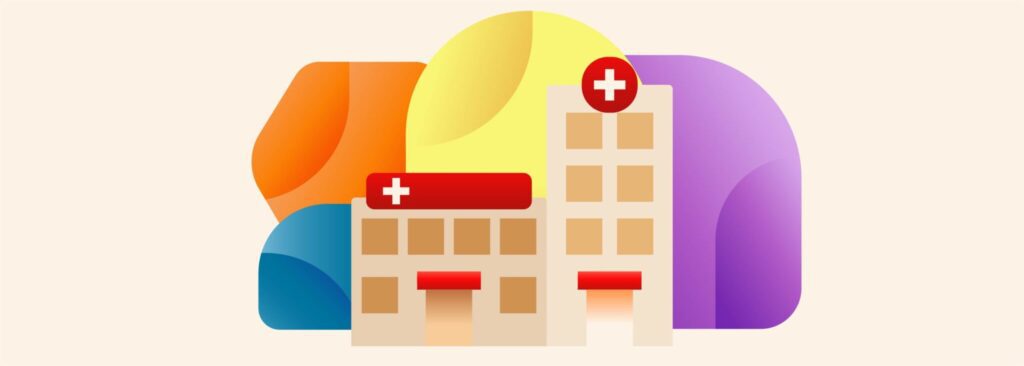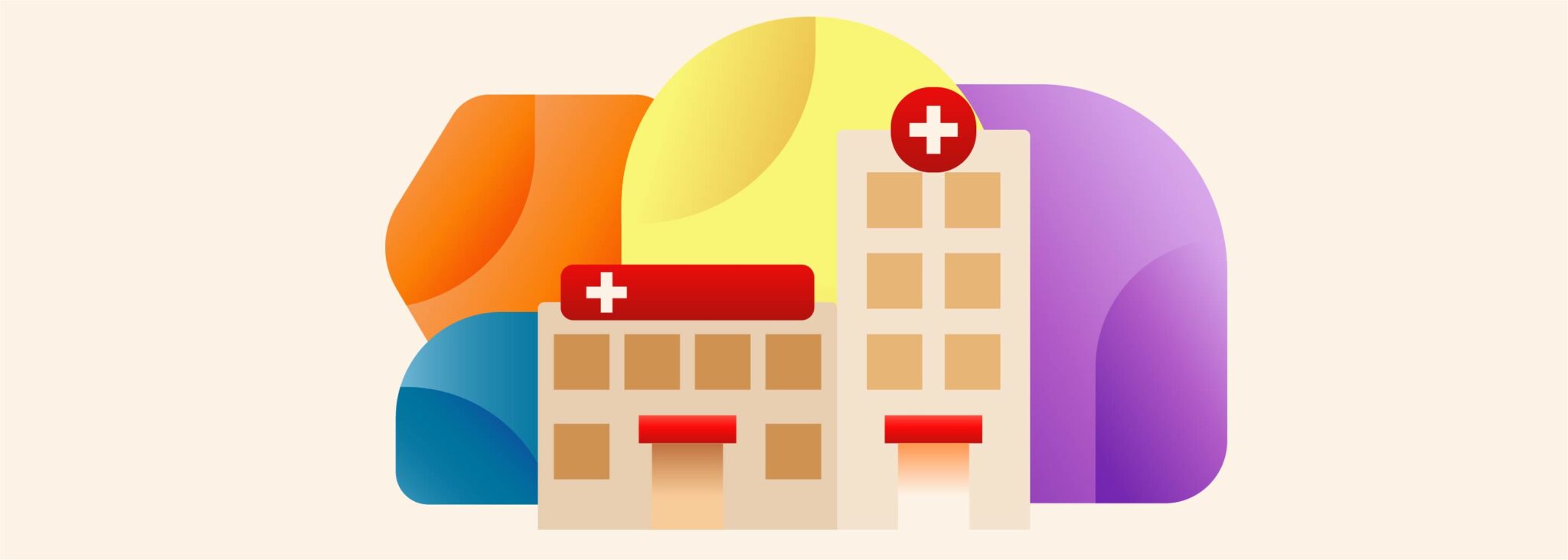
Hospitals operate as 24-hour-a-day businesses in an industry known for its fast pace. Additionally, healthcare organizations employ a wide range of staff, including clinicians, technicians, hospital safety officers, and other workers.
Within a healthcare facility, you encounter people such as patients, visitors, and vendors. Like any company’s work environment, hospital teams face safety and risk challenges. Indeed, OSHA data reveals that medical buildings experience work-related injuries. Moreover, auditors report over 200,000 injuries or illnesses among workers each year.
Furthermore, hospitals often deal with life and death situations as emergency department users arrive in real-time. Similarly, emergency rooms handle critical life safety events as routinely as customers walk into a retailer.
Given the volatile nature of hospitals, they must enhance efficiency and implement safety guidelines. In today’s regulatory environment, hospitals face intense scrutiny regarding standards, compliance, and security.
One day, a hospital might be part of a case study, and the next, it may face onsite inspections or audits. Hospitals must meet quality metrics set by the Centers for Medicare & Medicaid Services (CMS) and ISO health standards.
Moreover, other requirements might involve an Environmental Health and Safety (EHS) process or a National Fire Protection Association (NFPA) issue.
Consequently, equipment and assets undergo inspections for deficiencies and must adhere to standards for setup, repairs, and other action plans.
In years past, hospital centers created documentation by hand using pen and paper. Today, however, inspection forms, checklists, tasks, and codes must be documented electronically with software applications.
Software Solutions for Hospital Inspection Reports

Virtually all hospital units today connect electronically to the web. As a result, each location can share critical data in real-time. For example, a medical facility manager looking for a solution to document the inspection process has various options. Additionally, providers of these solutions often offer ongoing service and support.
Nevertheless, feedback from hospital industry experts shows that staffing shortages persist in the U.S. Therefore, hospitals struggle to maintain a sufficient staff for their seven-day schedule.
One step that medical facility professionals can take is adopting automation. Furthermore, most facilities and health systems have developed in-house IT and networking staff or partnered with a provider.
Common Characteristics of Inspection Software

Typically, software companies develop several types of solutions for healthcare facilities. Among the basic features are email integration, a mobile app, and accessibility through smartphones, tablets, iPads, or other mobile devices.
Most systems now feature cloud storage, enabling users to upload photos associated with digital inspections and create tickets and work orders. Clearly, simple ticket work order systems have become obsolete, and network security measures ensure peace of mind.
Thus, software systems should offer adaptability or customization for tools, reminders, and reporting capabilities. Furthermore, customization should align with the intended workflow, such as scheduling or current work orders.
Naturally, those in supervisory or managerial roles rely on inspection software to assess performance and accountability. For instance, a facility manager might customize reports based on variables like department, building, or specific employee.
Additionally, inspection software may also include key data for repurchasing supplies—such as inventory management tools. Moreover, many tools, equipment, systems, and components subject to inspection often come with warranties.
In terms of tool or equipment warranties, manufacturers or distributors might specify that the facility performs certain tasks. For example, a piece of equipment might require a weekly visual inspection and a more detailed monthly testing requirement.
Unfortunately, hospitals that fail to adhere to inspection or maintenance guidelines might experience system failures. As a result, these failures can lead to costly downtime that cannot be recovered and create collateral issues.
Furthermore, maintenance and inspection failures might cause delays if replacement components are unavailable or take days or weeks to ship. Keep in mind that neglecting inspections or maintenance might also void a tool or equipment’s warranty.
Having Inspection Documentation for NFPA Compliance
The National Fire Protection Association (NFPA) established NFPA 99, a set of standards known as the Health Care Facilities Code. Although NFPA guidelines generally focus on life safety and fire certification, this code goes further.
Specifically, a healthcare facility must assess the risk and impact of device, equipment, or system failures on patients. At the center of the risk assessment are concerns about injuries or fatalities among patients, clinicians, and staff.
The following table explains how risk is assessed and how critical preventative efforts should be prioritized.
| Risk Categories 4.1 | The Likely Outcome if a System, Device, or Equipment Failure Occurred |
| 4.1.1 Category 1 | May result in major injuries or fatalities among facility occupants |
| 4.1.2 Category 2 | May result in minor injuries among facility occupants |
| 4.1.3 Category3 | Is unlikely to result in injuries among facility occupants |
| 4.1.4 Category 4 | Poses no risk to building occupants |
Source: Consulting-Specifying Engineer
NFPA 99 applies to most medical buildings except those involved with home healthcare. In fact, the rules and requirements apply regardless of building occupancy, such as the number of beds, patient rooms, or maximum capacity.
The Most Critical Systems or Equipment to Inspect

According to the Health Care Facilities Code Handbook, the primary systems and equipment within a hospital or similar medical facility include:
– Gas Equipment and Vacuum Systems:
These involve pressurized medical gas systems, vacuum systems, and waste anesthetic gas disposal.
– Electrical Systems & Equipment:
Electricity is crucial in most facilities, and avoiding hazards such as electrical shock or fire is essential.
– Information Technology and Communications Systems:
Medical facilities today are increasingly more reliant on electronic technology, digital communications, and network storage; therefore, minimizing potential vulnerabilities is critical. The category may include nurse call systems and resuscitation alarms.
– Plumbing
– HVAC Systems:
Involves operations, efficiency, maintenance, and testing of heating, cooling, and ventilation systems in health care environments.
– Emergency Management:
Medical facilities develop plans in preparation for properly responding to potential disasters and recovery procedures. Some of the potential calamities involved include hurricanes, earthquakes, mass shootings, and other unforeseen problems.
– Security Management:
Security concerns extend broadly into an array of areas such as securing patient information or storage of controlled medications. Others might include background screening and drug testing of team members or contracted security personnel.
– Features of Fire Protection:
Most medical facilities have sprinkler systems. Moreover, certain parts of the sprinkler system require visual (only) inspection each week or month. In addition, major components need more detailed inspection quarterly, semi-annually, and annually. Fire extinguishers also require regular inspection. Furthermore, a professionally installed fire alarm system is necessary and subject to regular inspection and testing.
The Importance of Inspections & Documentation for Accident Prevention

Hospital environments are often unpredictable and stressful situations commonly arise requiring patience and diligence. Clinicians, caregivers, and others encountering patients assume a general duty to “not harm.”
Among the most common concerns in a hospital setting are slip-and-fall accidents, which occur frequently in these environments. Often patients struggle with mobility, are prescribed multiple medications and may have impaired vision—potentially exacerbating these concerns.
Falls are a leading cause of fractures such as those involving the hips or dangerous traumatic head injuries. Hospital staff also is often moving rapidly and experiencing fatigue, another possible contributing factor.
OSHA is among the agencies that remain most active in education and enforcement regarding hazards in the work environment. Slip-and-fall accidents highlight another reason why general inspections of existing conditions are critical.
For example, objects or debris situated on a flight of stairs can pose a legitimate danger. The same applies to spills near entryways that are a hazard.
Looking specifically at documentation, the Joint Commission currently posts standards for fire safety system inspection records and reports. Most of these specifications are straightforward including the name or type of activity, the date, and any inventory details.
Further, the Joint Commission requests that the scheduled or intended frequency of the inspection be noted. The individual performing the inspection should be noted along with a reference number or chapter of any corresponding NFPA standard(s).
Provider of Inspection Software Solutions for Hospital Facilities

The importance of proactively assessing all property conditions, equipment, and systems should not be underestimated. A regular plan of inspection, preventative maintenance, and testing, is critical for preventing injuries, system failure, and potential liability.
When inspections and related activities are performed, they must also be properly documented for a host of reasons. As technology has improved, creating this important history or documentation has become simpler.
Having a system that integrates with most devices, allows for some customization, and uses the latest in security technology is important. At Ranyan, our software solutions are available for hospitals and medical facilities that need assistance with organizing, scheduling, documenting, and more.
Hospital administrators, operations, and facility management teams will benefit from our technology for eliminating paperwork, enhancing communication, and much more. Contact us today for additional information.
Contact Us for Tailored Inspection Software Solutions
At Ranyan, we understand the unique challenges faced by hospitals and healthcare facilities in maintaining rigorous inspection standards and compliance. Our inspection software is designed to streamline your operations, enhance safety, and ensure all documentation meets regulatory requirements.
If you’re looking to improve your facility’s inspection processes, reduce the risk of non-compliance, and maintain a safe environment for patients and staff, our team is here to help. We provide personalized support to ensure that our solutions align with your specific needs.
For more information about our hospital inspection software, or to discuss how our solutions can benefit your facility, please reach out to us. You can contact us by by email at info@ranyan.com. We’re dedicated to helping you maintain the highest standards of safety and efficiency in your healthcare operations.





